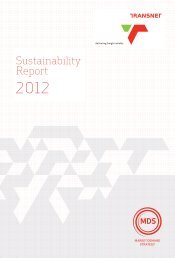Noise and Vibration Report - Transnet
Noise and Vibration Report - Transnet
Noise and Vibration Report - Transnet
- No tags were found...
You also want an ePaper? Increase the reach of your titles
YUMPU automatically turns print PDFs into web optimized ePapers that Google loves.
ENVIRO-ACOUSTIC RESEARCHSCOPING NOISE REPORT – TRANSNET: SWAZI RAIL LINK – DAVEL YARD TO NERSTON RSA ROUTEI (impulse) timeweightingImpulsive soundInfrasoundIntegratedDevelopmentPlanIntegratedEnvironmentalManagementInterested <strong>and</strong>affected partiesKey issueListed activitiesL AMin <strong>and</strong> L AMaxLoudnessMagnitude ofimpactMaskingMitigationNegative impact<strong>Noise</strong><strong>Noise</strong> Level<strong>Noise</strong>-sensitivedevelopment(1) Averaging detection time used in sound level meters as per South Africanst<strong>and</strong>ards <strong>and</strong> Regulations.(2) Impulse setting has a time constant of 35 milliseconds when the signal isincreasing (sound pressure level rising) <strong>and</strong> a time constant of 1,500milliseconds while the signal is decreasing.A sound characterized by brief excursions of sound pressure (transient signal)that significantly exceed the ambient sound level.Sound with a frequency content below the threshold of hearing, generally heldto be about 20 Hz. Infrasonic sound with sufficiently large amplitude can beperceived, <strong>and</strong> is both heard <strong>and</strong> felt as vibration. Natural sources ofinfrasound are waves, thunder <strong>and</strong> wind.A participatory planning process aimed at developing a strategic developmentplan to guide <strong>and</strong> inform all planning, budgeting, management <strong>and</strong> decisionmakingin a Local Authority, in terms of the requirements of Chapter 5 of theMunicipal Systems Act, 2000 (Act 32 of 2000).IEM provides an integrated approach for environmental assessment,management, <strong>and</strong> decision-making <strong>and</strong> to promote sustainable development<strong>and</strong> the equitable use of resources. Principles underlying IEM provide for ademocratic, participatory, holistic, sustainable, equitable <strong>and</strong> accountableapproach.Individuals or groups concerned with or affected by an activity <strong>and</strong> itsconsequences. These include the authorities, local communities, investors,work force, consumers, environmental interest groups <strong>and</strong> the general public.An issue raised during the Scoping process that has not received an adequateresponse <strong>and</strong> that requires further investigation before it can be resolved.Development actions that is likely to result in significant environmental impactsas identified by the delegated authority (formerly the Minister of EnvironmentalAffairs <strong>and</strong> Tourism) in terms of Section 21 of the Environment ConservationAct.Is the RMS (root mean squared) minimum or maximum level of a noise source.The attribute of an auditory sensation that describes the listener's ranking ofsound in terms of its audibility.Magnitude of impact means the combination of the intensity, duration <strong>and</strong>extent of an impact occurring.The raising of a listener's threshold of hearing for a given sound due to thepresence of another sound.To cause to become less harsh or hostile.A change that reduces the quality of the environment (for example, byreducing species diversity <strong>and</strong> the reproductive capacity of the ecosystem, bydamaging health, or by causing nuisance).a. Sound that a listener does not wish to hear (unwanted sounds).b. Sound from sources other than the one emitting the sound it is desired toreceive, measure or record.c. A class of sound of an erratic, intermittent or statistically r<strong>and</strong>om nature.The term used in lieu of sound level when the sound concerned is beingmeasured or ranked for its undesirability in the contextual circumstances.developments that could be influenced by noise such as:a) districts (see table 2 of SANS 10103:2008)1. rural districts,2. suburban districts with little road traffic,3. urban districts,4. urban districts with some workshops, with business premises, <strong>and</strong> withmain roads,5. central business districts, <strong>and</strong>6. industrial districts;b) educational, residential, office <strong>and</strong> health care buildings <strong>and</strong> theirsurroundings;c) churches <strong>and</strong> their surroundings;P a g e | 4
















